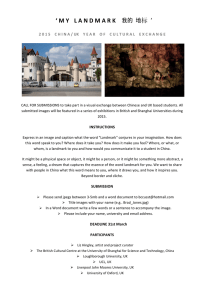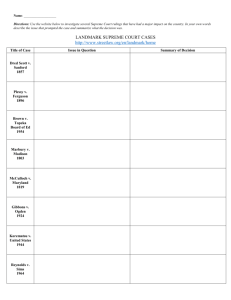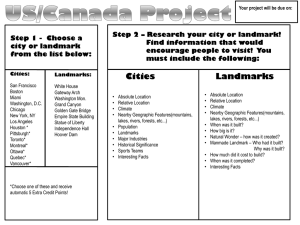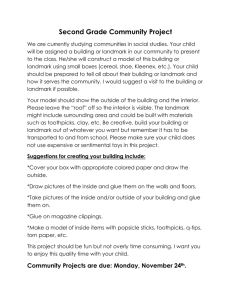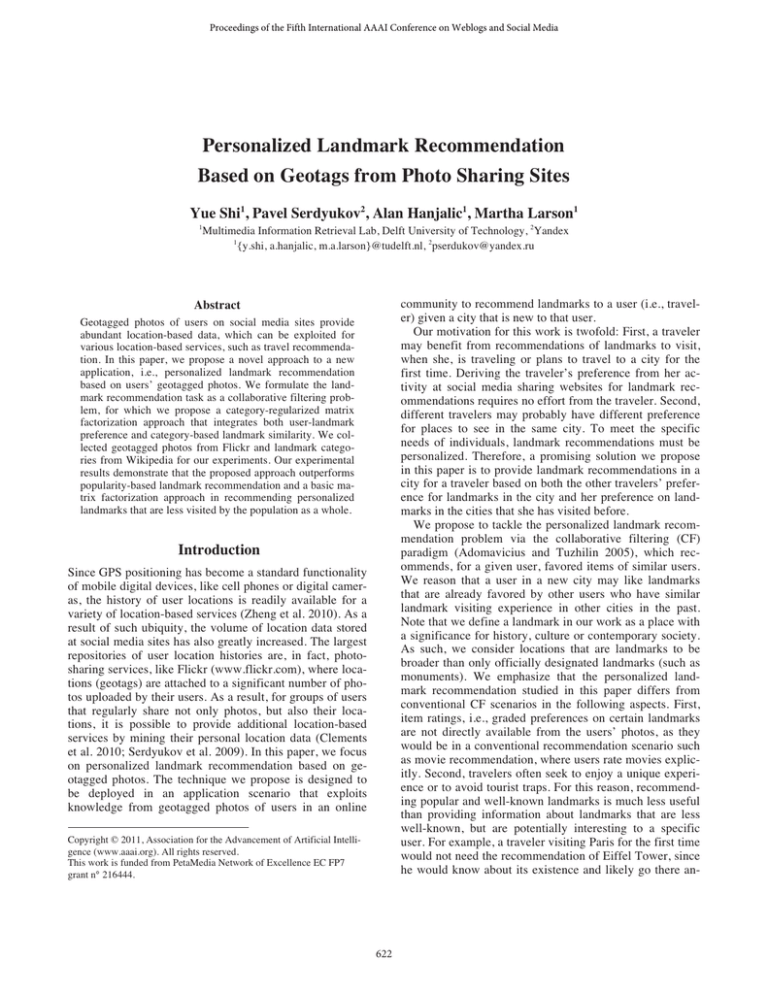
Proceedings of the Fifth International AAAI Conference on Weblogs and Social Media
Personalized Landmark Recommendation
Based on Geotags from Photo Sharing Sites
Yue Shi1, Pavel Serdyukov2, Alan Hanjalic1, Martha Larson1
1
Multimedia Information Retrieval Lab, Delft University of Technology, 2Yandex
1
{y.shi, a.hanjalic, m.a.larson}@tudelft.nl, 2pserdukov@yandex.ru
community to recommend landmarks to a user (i.e., traveler) given a city that is new to that user.
Our motivation for this work is twofold: First, a traveler
may benefit from recommendations of landmarks to visit,
when she, is traveling or plans to travel to a city for the
first time. Deriving the traveler’s preference from her activity at social media sharing websites for landmark recommendations requires no effort from the traveler. Second,
different travelers may probably have different preference
for places to see in the same city. To meet the specific
needs of individuals, landmark recommendations must be
personalized. Therefore, a promising solution we propose
in this paper is to provide landmark recommendations in a
city for a traveler based on both the other travelers’ preference for landmarks in the city and her preference on landmarks in the cities that she has visited before.
We propose to tackle the personalized landmark recommendation problem via the collaborative filtering (CF)
paradigm (Adomavicius and Tuzhilin 2005), which recommends, for a given user, favored items of similar users.
We reason that a user in a new city may like landmarks
that are already favored by other users who have similar
landmark visiting experience in other cities in the past.
Note that we define a landmark in our work as a place with
a significance for history, culture or contemporary society.
As such, we consider locations that are landmarks to be
broader than only officially designated landmarks (such as
monuments). We emphasize that the personalized landmark recommendation studied in this paper differs from
conventional CF scenarios in the following aspects. First,
item ratings, i.e., graded preferences on certain landmarks
are not directly available from the users’ photos, as they
would be in a conventional recommendation scenario such
as movie recommendation, where users rate movies explicitly. Second, travelers often seek to enjoy a unique experience or to avoid tourist traps. For this reason, recommending popular and well-known landmarks is much less useful
than providing information about landmarks that are less
well-known, but are potentially interesting to a specific
user. For example, a traveler visiting Paris for the first time
would not need the recommendation of Eiffel Tower, since
he would know about its existence and likely go there an-
Abstract
Geotagged photos of users on social media sites provide
abundant location-based data, which can be exploited for
various location-based services, such as travel recommendation. In this paper, we propose a novel approach to a new
application, i.e., personalized landmark recommendation
based on users’ geotagged photos. We formulate the landmark recommendation task as a collaborative filtering problem, for which we propose a category-regularized matrix
factorization approach that integrates both user-landmark
preference and category-based landmark similarity. We collected geotagged photos from Flickr and landmark categories from Wikipedia for our experiments. Our experimental
results demonstrate that the proposed approach outperforms
popularity-based landmark recommendation and a basic matrix factorization approach in recommending personalized
landmarks that are less visited by the population as a whole.
Introduction
Since GPS positioning has become a standard functionality
of mobile digital devices, like cell phones or digital cameras, the history of user locations is readily available for a
variety of location-based services (Zheng et al. 2010). As a
result of such ubiquity, the volume of location data stored
at social media sites has also greatly increased. The largest
repositories of user location histories are, in fact, photosharing services, like Flickr (www.flickr.com), where locations (geotags) are attached to a significant number of photos uploaded by their users. As a result, for groups of users
that regularly share not only photos, but also their locations, it is possible to provide additional location-based
services by mining their personal location data (Clements
et al. 2010; Serdyukov et al. 2009). In this paper, we focus
on personalized landmark recommendation based on geotagged photos. The technique we propose is designed to
be deployed in an application scenario that exploits
knowledge from geotagged photos of users in an online
Copyright © 2011, Association for the Advancement of Artificial Intelligence (www.aaai.org). All rights reserved.
This work is funded from PetaMedia Network of Excellence EC FP7
grant n° 216444.
622
yway. However, he would appreciate recommendations of
landmarks that are less visited by the general population,
but rather fit his own interests well. Third, the number of
visited landmarks for most of the users could be very limited, resulting in a very sparse user-landmark relation. Although data sparseness is a typical problem in common CF
scenarios, we anticipate that it is more severe in landmark
recommendation than in other scenarios, e.g., movie or
music recommendation. Visiting landmarks is based on the
availability of money, time and travel documents (e.g.,
valid visa). For these reasons, an individual user might
have visited only relatively few of the very large total
number of landmarks.
Our contributions in this paper can be summarized as
follows. First, we put forward a new research topic, namely, personalized landmark recommendation using users’
geotagged photos, and contribute a new data collection for
this research. Second, we propose a novel approach, category-regularized matrix factorization, that exploits both
user-landmark preference and category-based landmark
similarity for personalized landmark recommendation, and
demonstrate its effectiveness for recommending lessvisited landmarks.
al. 2010). This work discovered the dominant effect of
popular locations in recommendation, which is also confirmed in our experiments, and also suggested that recommendations for less-frequently visited locations would be
more interesting to travelers, the focus evaluated in this
paper. The other instance of closely related work, (Kurashima et al. 2010), proposed to construct a generative
photographer behavior model for personalized travel route
recommendation by combining a Markov model for location dependence and a topic model for user interest dependence. Users’ travel route histories were represented by
geotags of their photos, and the ordering of locations was
represented by the timestamps of users’ photos. Compared
to their work, our approach is substantially different in two
aspects: First, our work focuses on a new application, i.e.,
landmark recommendation. Second, we specifically target
the data sparseness problem and the challenge of recommending less frequently visited locations, both of which
have not been investigated before.
Our work in this paper is also related to matrix factorization (MF) techniques in recommender systems. Generally,
MF techniques (Koren et al. 2009) learn latent features of
users and items from the observed preference in the useritem matrix and these features are then used to predict unobserved preferences. Recently, different regularizations
have been proposed to extend the basic MF in order to
make it suited for different purposes. For example, Ma et
al. (2009) proposed to use the social relationships among
users in a networked community to regularize the factorization of the user-item rating matrix for improved rating
prediction. Furthermore, Zheng et al. (2010) proposed to
deploy user activity correlation and location correlation in
terms of location features to regularize the factorization of
a location-activity matrix for improved location and activity recommendation. Also, Shi et al. (2010) proposed to use
movie mood properties to regularize the factorization of a
user-movie rating matrix for improved mood-specific movie recommendation. In this paper, we exploit landmark
categories derived from Wikipedia to regularize the factorization of user-landmark preference matrix for improved
landmark recommendation.
Related Work
Our work in this paper is related to location-based recommendation. Location data from user-uploaded photos, i.e.,
the geotags of photos, has been exploited to approach various tasks. A travel guidance system (Gao et al. 2010) was
presented to automatically recognize and rank landmarks
based on the tags and geotags of photos in Flickr and on
the information extracted from online community travel
sites, like Yahoo Travel Guide (travel.yahoo.com). The
geotags of photos were also exploited for facilitating trip
planning (Lu et al. 2010) in order to help travelers to discover attractive places/landmarks, find a proper path
around a landmark, and find a proper route between landmarks. Arase et al. (2010) proposed to use geotagged photos to mine frequent trip patterns, i.e., frequently visited
city sequences and typical visit duration, factors that are
widely recognized for their potential for improving travel
recommendation. De Choudhury et al. (2010) proposed to
construct travel itineraries automatically by aggregating
users’ location data, e.g., staying time in a place, transit
time between places, etc., which are extracted from geotagged photos. These approaches all address the problem
of the general optimization of travel guides by relying on
different available information resources. In contrast, the
work in this paper addresses personalized landmark recommendation task, i.e., recommendations are generated in
view of each user’s individual preference.
To the best of our knowledge, there are only two studies
that are closely related to this paper in that they also focus
on personalized location-based recommendation. One of
them proposed to personalize location prediction by exploiting geotagged photos to re-rank popular locations by
integrating predictions based on similar users (Clements et
Category-regularized Matrix Factorization
In this section, we present the category-regularized matrix
factorization (CRMF) approach for personalized landmark
recommendation. Supposing there are M users and N
landmarks, we integrate the category-based landmark similarity with the basic MF approach, which leads to the following objective function of CRMF:
L ( U, V ) =
+
2
2
1 M N R
N N
I ij ( Rij U iT V j ) + I Sjn ( S jn V jT Vn )
2 i =1 j =1
2 j =1 n =1
2
(U
2
F
+ V
2
F
(1)
)
where Rij denotes the user i’s preference on landmark j.
Note that in this paper we use the normalized number of
623
photos that user i took around landmark j to represent Rij.
Ui denotes the d-dimensional latent features (as a column
vector) of user i, and Vj denotes the d-dimensional latent
features (as a column vector) of landmark j. IijX is an indicator function that is equal to 1 if Xij>0, and 0 otherwise.
||U||F and ||V||F are the Frobenius norm of U and V, respectively, that serve to alleviate overfitting. is the norm regularization parameter. Sjn denotes cosine similarity between
landmark j and landmark n in terms of their categories.
Note that in this paper we exploit landmark categories
from Wikipedia. A tradeoff parameter, i.e., , serves to
control the relative contribution from the category-based
landmark similarity to the learned latent features. Note that
CRMF becomes equivalent to the basic MF when is
equal to 0. Minimizing the objective function results in the
latent features of users and landmarks learned from the
user-landmark preference in R and from the categorybased landmark similarity in S.
Since the objective function is not jointly convex over U
and V, we choose to use alternated gradient descent to
solve the minimization problem. With the learned latent
features of U and V, we can predict user i’s preference on
landmark j as UiTVj, which provides the basis for ranking
landmarks for personalized recommendations. Note that in
the recommendation list we exclude the landmarks that the
user has already visited.
100000
10000
1000
100
10
1
1
10
100
1000
Number of landmarks
Number of users
In addition, we extracted categories for each landmark
from Wikipedia, which resulted in a landmark-category
binary matrix with 7,379 categories. The landmark category is used as another modality, independent of userlandmark preference, from which category-based landmark
similarity can be obtained. The dataset is available at
(http://homepage.tudelft.nl/q0v1y/yueshi/plr_data.zip).
10000
1000
100
10
1
1
10
100
1000
10000
Number of landmarks visited
Number of visiting users
(a)
(b)
Fig. 1. (a) Log-log plot relating the number of users to the
numbers of visited landmarks, (b) Log-log plot relating the
number of landmarks to the number of visiting users.
Experimental Evaluation
The most straightforward application from this study is to
provide a user with landmark recommendations when she
plans to visit a city. Our experiments are intended to evaluate the proposed CRMF approach for personalized landmark recommendation under a simulated setting that approximates this application. For this reason, in our experiments we use only the data of those users who have visited
at least one landmark in each of at least two cities. In this
way, we can define at least one “already visited” and at
least one “target” city for each user. The user-landmark
matrix used for the experiments contains 14,031 users and
has a sparseness of 99.89%.
We randomly separate the dataset into a training set, a
validation set and a test set. For the training set, we randomly select 60% users and their landmark preferences.
We then randomly select another 20% users and their
landmark preferences to form the validation set, which is
used to tune parameters. The remaining 20% users and
their preferences are used as the test set, which is used to
evaluate the performance of CRMF and compare it to that
of the baselines. We adopted one of the most widely used
evaluation metrics, i.e., mean average precision (MAP) to
evaluate the recommendation quality. The higher the MAP,
the better is the recommendation performance. When evaluating the CRMF performance, for each user in the validation and test set, we randomly select one city that she has
visited as that user’s target city. Then we remove the user’s
landmark preferences for this selected target city and try to
reproduce them. We compare landmark recommendation
algorithms on the basis of their ability to predict the deleted landmark preferences in terms of MAP.
According to observations from the validation set, we
set =1 and the tradeoff parameter =0.001. With this
fixed parameter setting, we compare CRMF with two baseline approaches on the test set:
Data Description
The data for our experiments was collected using public
Flickr API. First, we downloaded metadata for 42.9M geotagged photos and then filtered this data according to the
following criteria. Considering that the overwhelming majority of Flickr users are from the US, we focused only on
users with geotagged photos made outside the US in order
to increase the share of “travelers” in our dataset. We also
only considered the photos of city landmarks and continued with 40 cities in which the most photos were taken.
The above steps resulted in 126,123 geotagged photos
from 40,084 users. We extracted landmarks for each photo
corresponding to geotagged Wikipedia articles that are less
than one kilometer away from the geotag of that photo. In
addition, we eliminated landmarks for which there was
negligible overlap between the words in the title of the
Wikipedia article and the tags assigned to the photo by the
user. Finally, as mentioned above, we used the normalized
number of a user’s photos related to a landmark to quantify
a user’s preference for a landmark. The resulting userlandmark preference matrix consists of 260,362 scores
from 40,084 users and 9,557 landmarks.
Fig. 1 indicates that both users and landmarks closely
follow a power-law distribution, from which two conclusions could be drawn: 1) most of the users in our dataset
visited only a limited number of landmarks (Fig. 1(a)),
resulting in a sparse user-landmark preference matrix; 2)
there are quite a few landmarks visited by lots of users
(Fig. 1(b)), which makes the challenge and importance of
recommending less-popular landmarks quite substantial.
624
-
PopRec: Landmarks are recommended to users based
on their popularity, which is defined in terms of the
number of users who visited them in the training set. It
is a non-personalized recommendation approach: every
user in the test set will get the same recommendations.
- MF: We use the basic matrix factorization approach to
represent a state-of-the-art CF approach.
By assuming that the numbers of most popular (and therefore irrelevant) landmarks in each city are different and by
letting them vary between 0 and 10, we can observe the
performance of the proposed CRMF and its relative improvement over the baseline approaches, as shown in Table
1. We use “0” (in the first column) to denote the case
where no assumption of the relevance of most popular
landmarks is made, and we measure the performance according to the ground truth in the test set.
As can be seen from Table 1, PopRec outperforms MF
and CRMF under the condition that no popular landmarks
are assumed irrelevant. However, as stated before, we are
mainly concerned about the recommendation performance
for landmarks less frequently visited by the general population, i.e., those a traveler may not know about beforehand.
If the most popular landmark in each city is ignored, we
can see that CRMF outperforms PopRec by ca. 7% in
MAP. When different numbers of the most popular landmarks are ignored, CRMF achieves improvement over PopRec up to ca. 32% in MAP. Finally, we can observe that
CRMF consistently outperforms MF under all conditions,
achieving improvement up to ca. 12% in MAP.
Conclusions and Future Work
In this paper, we put forward a new research challenge on
personalized landmark recommendation based on geotagged photos from users on photo sharing sites. We propose a novel category-regularized matrix factorization approach to recommend landmarks to individual users based
on both user-landmark preference information and category-based landmark similarity. We observe that personalized landmark recommendation must go beyond recommending the most popular, widely visited landmarks, and
instead focus on less frequently visited landmarks that are
well-fit to users’ individual tastes. The proposed CRMF
approach is able to exploit category-based landmark similarity to provide improved recommendation according to
this criterion. Improvement is shown with respect to a popularity-based baseline and a MF approach that exploits
only user-landmark preference information.
Our future work on this topic will involve investigation
on integrating additional information resources besides
landmark category into personalized landmark recommendation, and analyzing the influence of users’ travel experience.
References
Adomavicius, G., and Tuzhilin, A., 2005. Toward the next generation of
recommender systems: A survey of the state-of-the-art and possible extensions. IEEE TKDE, 17, 6, 734-749.
Arase, Y., Xie, X., Hara, T., and Nishio, S., 2010. Mining people's trips
from large scale geo-tagged photos. In MM 10, 133-142.
Table 1. MAP comparison of CRMF and baseline approaches
under removal of a different number (first column) of the
most popular landmarks in each city.
PopRec MF CRMF
0
1
2
3
4
5
6
7
8
9
10
0.402
0.224
0.153
0.121
0.100
0.085
0.073
0.064
0.058
0.052
0.048
0.377
0.238
0.168
0.138
0.123
0.102
0.083
0.075
0.066
0.060
0.056
0.384
0.240
0.172
0.140
0.126
0.106
0.087
0.082
0.072
0.065
0.063
Gain over
PopRec
-4.6%
7.2%
12.5%
15.6%
26.3%
24.9%
20.2%
28.3%
25.1%
26.4%
31.6%
Clements, M., Serdyukov, P., de Vries, A. P., and Reinders, M. J., 2010.
Using Flickr geotags to predict user travel behaviour. In SIGIR 10, 851852.
Gain over
MF
1.8%
0.8%
2.4%
1.3%
2.3%
3.6%
5.7%
8.9%
8.9%
8.6%
11.7%
De Choudhury, M., Feldman, M., Amer-Yahia, S., Golbandi, N., Lempel,
R., and Yu, C., 2010. Automatic construction of travel itineraries using
social breadcrumbs. In HT 10, 35-44.
Gao, Y., Tang, J., Hong, R., Dai, Q., Chua, T.-S., and Jain, R., 2010.
W2Go: a travel guidance system by automatic landmark ranking. In MM
10, 123-132.
Koren, Y., Bell, R., and Volinsky, C., 2009. Matrix factorization techniques for recommender systems. IEEE Computer, 42, 8, 30-37.
Kurashima, T., Iwata, T., Irie, G., and Fujimura, K., 2010. Travel route
recommendation using geotags in photo sharing sites. In CIKM 10, 579588.
Lu, X., Wang, C., Yang, J.-M., Pang, Y., and Zhang, L., 2010. Photo2Trip: generating travel routes from geo-tagged photos for trip planning. In MM 10, 143-152.
Ma, H., Lyu, M. R., and King, I., 2009. Learning to recommend with trust
and distrust relationships. In RecSys '09, 189-196.
We also observe that, in general, the greater the number
of popular landmarks that are ignored, the more relative
improvement is achieved by CRMF over MF. This pattern
indicates that category-based landmark similarity is not
only helpful for improving general recommendation performance, but also for recommending less-visited landmarks. Note that all the improvements are statistically significant according to Wilcoxon signed rank significance
test with p<0.05 measured across all users in the test set.
Serdyukov, P., Murdock, V., and van Zwol, R, 2009. Placing Flickr photos on a map. In SIGIR 09, 484-491.
Shi, Y., Larson, M., and Hanjalic, A., 2010. Mining mood-specific movie
similarity with matrix factorization for context-aware recommendation. In
CAMRa '10, 34-40.
Zheng, V. W., Zheng, Y., Xie, X., and Yang, Q., 2010. Collaborative
location and activity recommendations with GPS history data. In WWW
10, 1029-1038.
625


